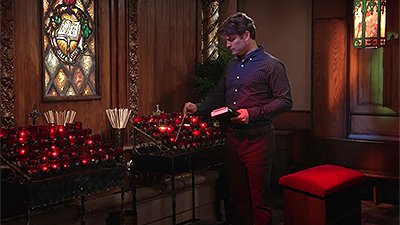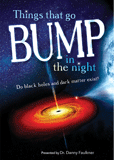
Cosmos Review: “Hiding in the Light”
Episode Five of Cosmos: A SpaceTime Odyssey
Cosmos Articles and Discussion Guides
See Cosmos: A SpaceTime Odyssey for reviews of other episodes and discussion guides for further study.
Cosmos: A SpaceTime Odyssey episode five, “Hiding in the Light,” though opening and closing with allusions to the supposed big bang birth of the universe billions of years ago, devotes most of its airtime to observational science. The speed of light was covered in last week’s episode, leaving this week’s episode to focus on other properties of light, carrying viewers from prisms to spectral examination of stars.
Shoulders of Giants
A multicultural array of people made discoveries relevant to components of light and the way light can be used to transmit an image. The first portion of the Cosmos episode “Hiding in the Light” points to a few of them. While today we realize that scientific discoveries come through controlled, repeatable tests that objectively consider the various components of a problem, not every culture has embraced the scientific method—but these men intuitively did. China’s 5th century BC philosopher Mozi (Mo-Tzu), the 11th century Arabian Ibn Alhazen (Ibn al-Hasan, Ibn al-Haytham), 17th century British genius Isaac Newton, 18th century Hanoverian astronomer William Herschel, and the 18th–19th century Bavarian Joseph von Fraunhofer all lived long before Einstein and observed many principles foundational to our modern understanding of light.
All the biographies are told in a way to emphasize the importance of an open exchange of ideas in order for scientific progress to continue building on itself. This is particularly ironic given the current climate in which many mainstream evolutionary scientists, educational associations, and popular personalities wish to restrict academic freedom and prevent students from learning to critically examine the unverifiable claims of the evolutionary version of our origins. Critical thinking skills include the ability to discern the difference betweenobservational science, such as that which has led to the discoveries of the properties of light and so many other phenomena, and historical (origins) science, which interprets observations through the lens of a scientist’s worldview.
Historical Note
For the sake of historical accuracy, we must mention that Tyson’s scriptwriters failed him a bit this week. Tyson correctly reported that China’s Mozi likely developed a camera obscura centuries before anyone else and that he also promoted the idea of “universal love” and opposed oppression. (Mozi and Confucius were actually just two of the many Chinese philosophers of the time who wrote about history, morality, human nature, and the political philosophy most likely to promote stability in that war-torn time. Mozi differed from Confucius primarily in advocating the idea that moral responsibility extended to all.) Tyson reported, however, that “the world’s first book burning” took place under the rule of China’s first Qin emperor—famed for the 7000 terra cotta warriors in his tomb—under the influence of the political philosophy of Legalism. While most of Mozi’s writings may have well perished in those third-century-BC flames, this was not the first book burning.
According to Legalist Chinese philosopher Han Fei (Han Feizi), the first book burnings began more than a century before the Qin emperor's campaign. Qin state minister Shang Yang began the process of Chinese unification by administering a ruthless Legalistic regime in which only what promoted the power of the state and its ability to control individuals and the economy was permitted. As a result, he began burning Confucian texts. Han Fei’s contemporaries in the unified Qin empire later reinstituted and expanded the practice, their ongoing aim being to destroy all versions of history that disputed their position and supremacy, much like all modern totalitarian regimes.
Scientific Method Then and Now
At any rate, the opening half of this episode “Hiding in the Light” used the stories of these pioneers in the physics of light to emphasize the value of the scientific method—the fact that scientific ideas need to be critically and objectively examined and tested. It is sad that despite this supposed willingness and even necessity to “question authority” (as Tyson repeatedly mentions in the series), evolutionary scientists continue to cling to the notion that those aspects of their philosophy—which cannot be tested and would even violate the observable laws of nature—are immune to questions and presumed true by scientific fiat. The evolutionary worldview presumes natural processes produced everything and only seeks to then explain “how.”
Light and Star Stuff
The rest of the latest Cosmos episode “Hiding in the Light” dealt primarily with observable principles about light. He discussed how China’s Mozi and others learned that a pinhole aperture to admit a focused beam of light made it possible to create a sharp image. Starting with the fact that light rays travel in a straight line but change speed and direction when they enter a new medium, like a prism, Tyson covered the concept of wavelength and explained how a prism divides white light into its color components. He discussed dark matter and the quantum nature of the electron’s behavior, and from that information he explained the science of spectroscopy.

This absorption spectrum shows black Fraunhofer lines, named in honor of their Bavarian discoverer. They represent the wavelengths of light absorbed by the atoms and molecules in a substance. Each element has a characteristic pattern determined by the quantum differences in the energy levels electrons can occupy. Spectrographic examination of stars makes it possible to determine the elements of which they are made. (Image courtesy of Wikipedia.)
By analyzing the spectra of light emitted from stars, scientists can see the signatures of individual elements and thus know what elements are out there in space. Because spectroscopy demonstrates that the same elements that we have here on Earth are present in space, Tyson links this observation—“spectral lines reveal that the visible cosmos is all made of the same elements”—to unverifiable evolutionary beliefs of big bang origins and the evolution of life from non-living chemicals. Accompanied by the rising strains of the soundtrack Tyson says, “The planets, the stars, the galaxies, we ourselves and all of life—the same star stuff.” Yet nothing in biology has ever demonstrated that life can evolve from non-life.
After touching on Christian astronomer Sir William Herschel’s discovery of the infrared portion of the spectrum, Tyson went on to mention the other sorts of light in the electromagnetic spectrum, each defined by its characteristic range of wavelengths and energy. The scenes featured in the closing moments of the program included gamma-ray bursts visible near the limits of the observed universe.
After so many great examples of the way observational science reveals how natural phenomena work and gives us the ability to develop powerful technologies, Tyson closes the program with a final shift into the realm of historical, worldview-based origins science. At the same time he (or his scriptwriters) makes another bit of slip when—waxing poetic—he says, “And in microwave light we can see all the way back to the birth of our universe.” Tyson refers to the cosmic microwave background (CMB)—radiation with a temperature of only a few degrees Kelvin that fills the universe. Answers in Genesis astronomer Dr. Danny Faulkner notes that even evolutionary astrophysicists like Tyson don’t really claim that the CMB dates back to the universe’s beginnings, observing,
At the end of the program, Tyson said, “In microwave light we can see all the way back to the birth of our universe.” I don’t think that Tyson actually believes this. The big bang model predicted the cosmic microwave background (CMB), but the CMB supposedly dates from the age of recombination, about 380,000 years after the big bang. In a 13.8 billion-year-old universe, the 380,000 is much closer to the beginning that we are today, but it still doesn’t take us to the birth of the big bang universe.
Cosmic microwave background is generally seen as the best evidence for the big bang, for the big bang model was used to predict its existence. The fact that CMB viewed from opposite parts of the sky has exactly the same temperature creates significant difficulties for the big bang model, however. This is called the horizon problem. You can read more about CMB in these articles:
- Has Cosmic Inflation Been Proved?
- Have Cosmologists Discovered Evidence of Inflation?
- Comments on the Cosmic Microwave Background
The big bang model has other problems too, and Dr. Faulkner addresses a number of these in “Problems with the Big Bang,” a chapter in his book Universe by Design.
When it comes to scientific ideas about our origins, frankly the greatest mistake a scientist can make is to ignore the eyewitness testimony of the Creator of the universe. In seeking to know the truth about when and how we, our world, and the universe got here, the history in God’s Word is the yardstick by which a wise scientist can evaluate ideas about origins and even make predictions worthy of being tested. Read more about how Bible-believing scientists are able to use God’s Word to make valuable testable scientific predictions in “Can Bible-Based Predictions Lead to Scientific Discoveries?” and “Does the Creation Model Make Predictions? Absolutely!” There really is no conflict between observational science, which is the focus of most of this episode of Cosmos: A SpaceTime Odyssey, and the Word of the Creator who made all things, even the laws of nature that science has discovered.
For more information:
- Cosmos Review: “Standing Up in the Milky Way”
- Cosmos Review: “Some of the Things Molecules Do”
- Cosmos Review: “When Knowledge Conquered Fear”
- Can Bible-Based Predictions Lead to Scientific Discoveries?
- De-Nyeing Science
- Deceitful or Distinguishable Terms—Historical and Observational Science
- Stardust Latest Suspect for Origin of Life
Recommended Resources

Answers in Genesis is an apologetics ministry, dedicated to helping Christians defend their faith and proclaim the good news of Jesus Christ.
- Customer Service 800.778.3390
- Available Monday–Friday | 9 AM–5 PM ET
- © 2025 Answers in Genesis





